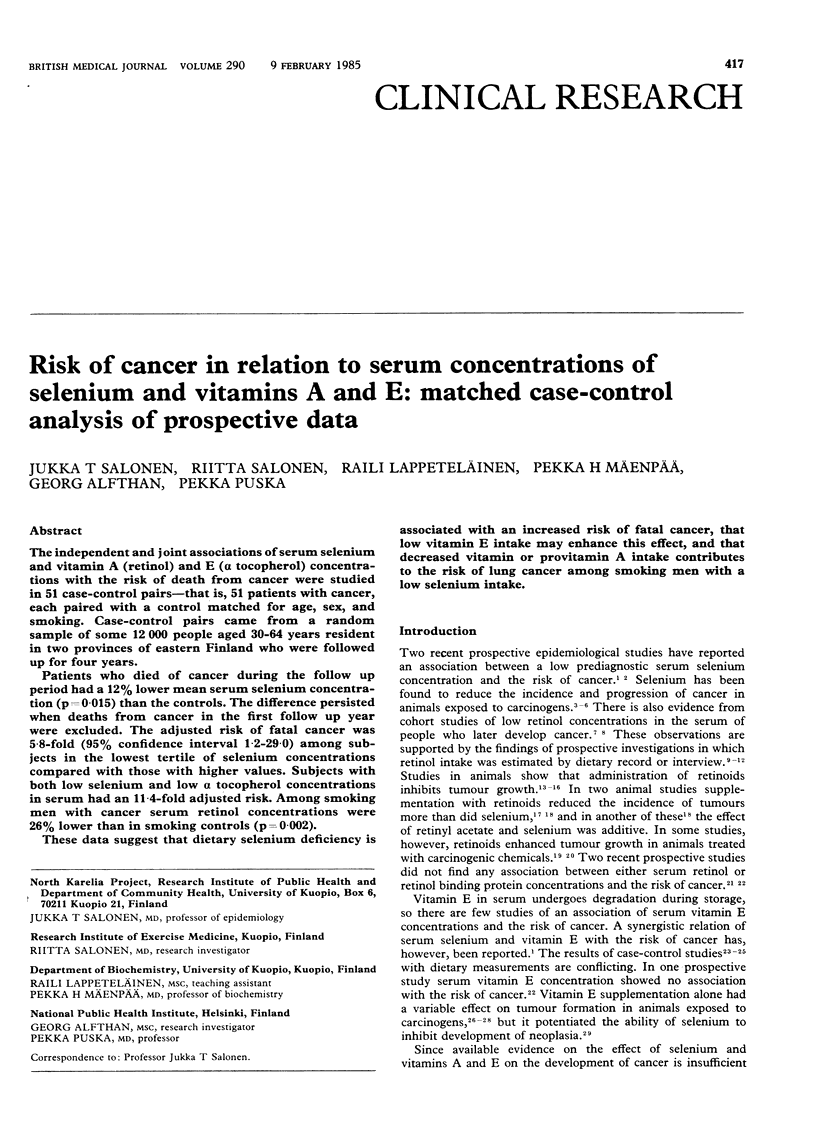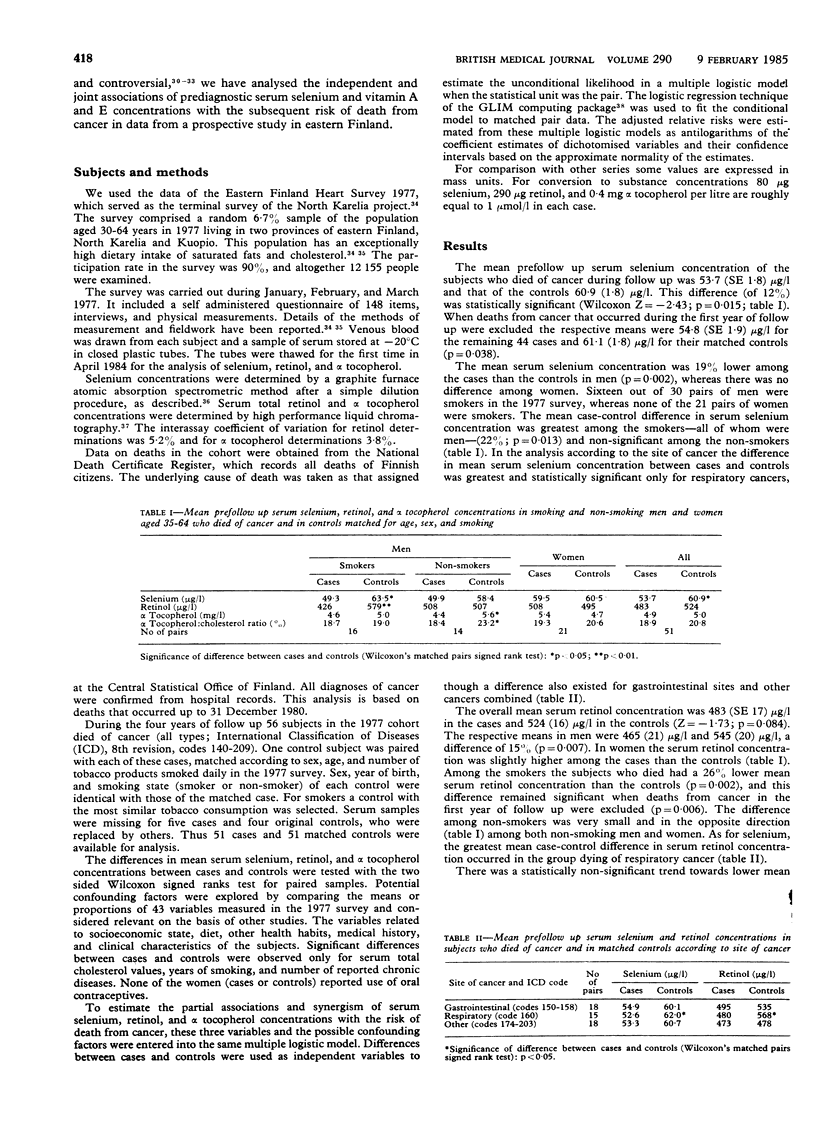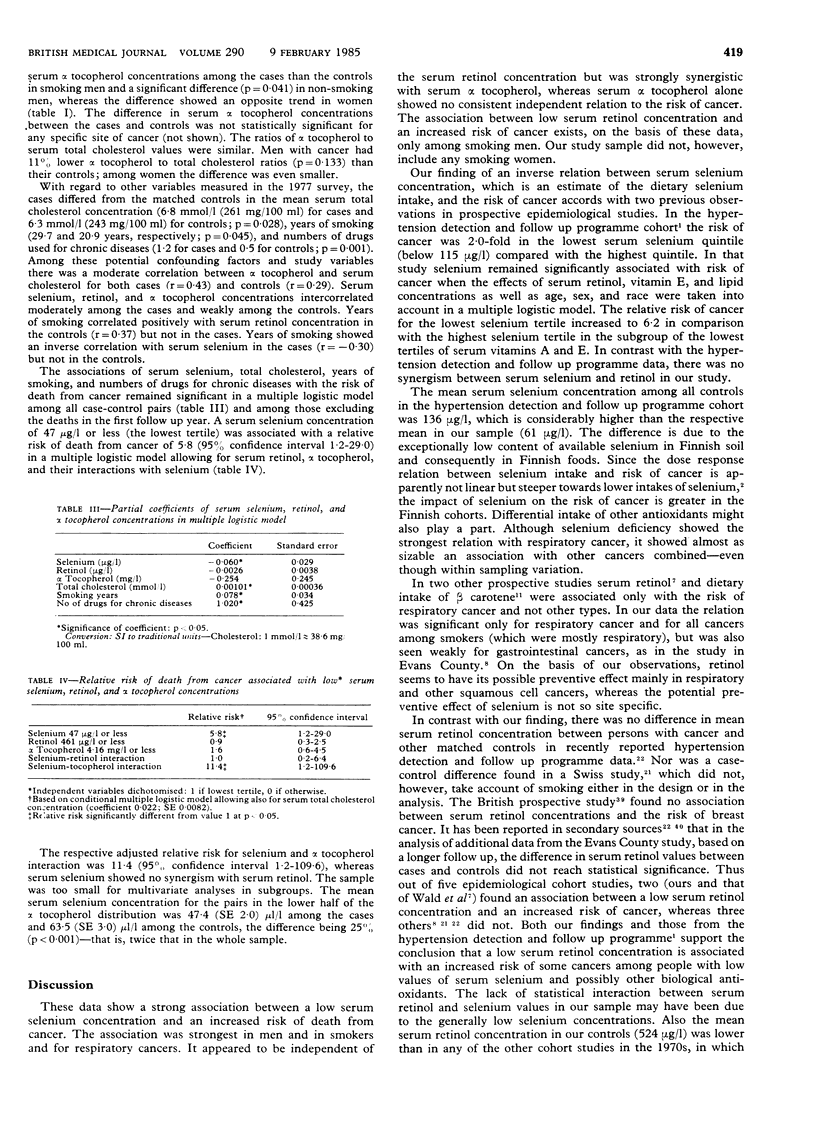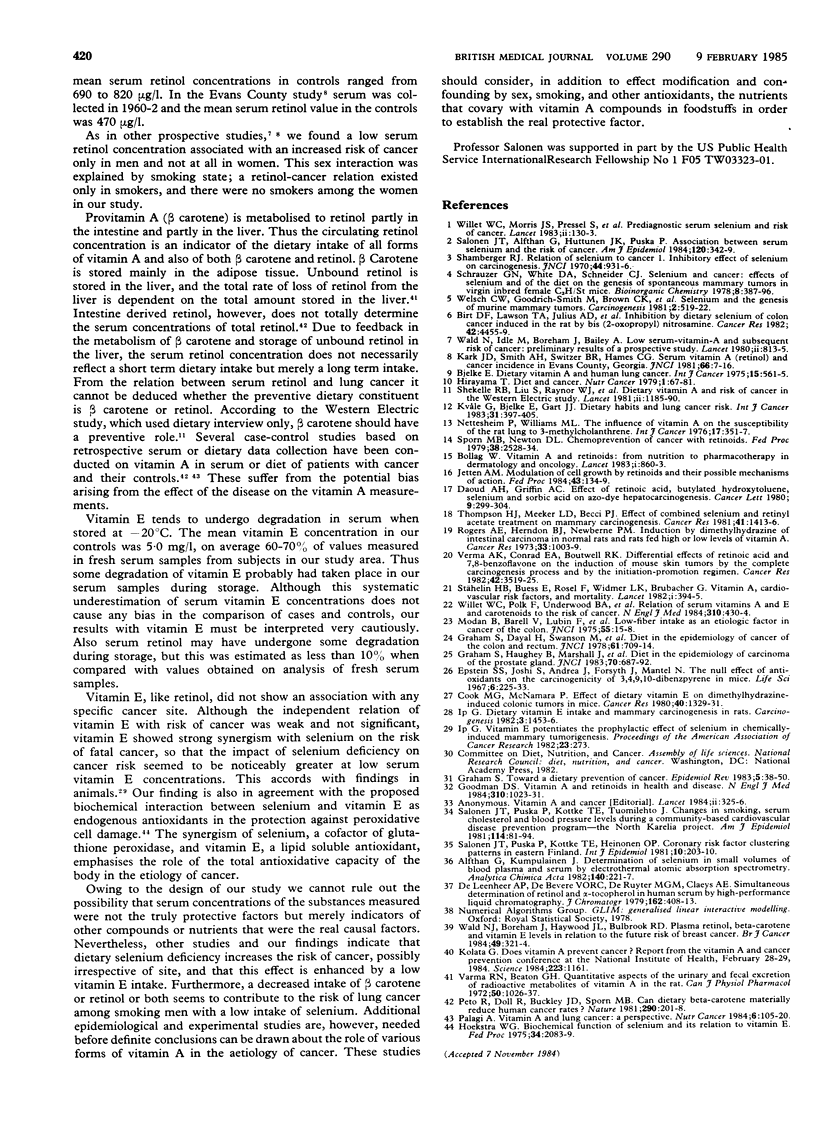Abstract
The independent and joint associations of serum selenium and vitamin A (retinol) and E (alpha tocopherol) concentrations with the risk of death from cancer were studied in 51 case-control pairs--that is, 51 patients with cancer, each paired with a control matched for age, sex, and smoking. Case-control pairs came from a random sample of some 12000 people aged 30-64 years resident in two provinces of eastern Finland who were followed up for four years. Patients who died of cancer during the follow up period had a 12% lower mean serum selenium concentration (p = 0.015) than the controls. The difference persisted when deaths from cancer in the first follow up year were excluded. The adjusted risk of fatal cancer was 5.8-fold (95% confidence interval 1.2-29.0) among subjects in the lowest tertile of selenium concentrations compared with those with higher values. Subjects with both low selenium and low alpha tocopherol concentrations in serum had an 11.4-fold adjusted risk. Among smoking men with cancer serum retinol concentrations were 26% lower than in smoking controls (p = 0.002). These data suggest that dietary selenium deficiency is associated with an increased risk of fatal cancer, that low vitamin E intake may enhance this effect, and that decreased vitamin or provitamin A intake contributes to the risk of lung cancer among smoking men with a low selenium intake.
Full text
PDF



Selected References
These references are in PubMed. This may not be the complete list of references from this article.
- Birt D. F., Lawson T. A., Julius A. D., Runice C. E., Salmasi S. Inhibition by dietary selenium of colon cancer induced in the rat by bis(2-oxopropyl)nitrosamine. Cancer Res. 1982 Nov;42(11):4455–4459. [PubMed] [Google Scholar]
- Cook M. G., McNamara P. Effect of dietary vitamin E on dimethylhydrazine-induced colonic tumors in mice. Cancer Res. 1980 Apr;40(4):1329–1331. [PubMed] [Google Scholar]
- Daoud A. H., Griffin A. C. Effect of retinoic acid, butylated hydroxytoluene, selenium and sorbic acid on azo-dye hepatocarcinogenesis. Cancer Lett. 1980 Jun;9(4):299–304. doi: 10.1016/0304-3835(80)90021-x. [DOI] [PubMed] [Google Scholar]
- De Leenheer A. P., De Bevere V. O., De Ruyter M. G., Claeys A. E. Simultaneous determination of retinol and alpha-tocopherol in human serum by high-performance liquid chromatography. J Chromatogr. 1979 Mar 1;162(3):408–413. doi: 10.1016/s0378-4347(00)81528-5. [DOI] [PubMed] [Google Scholar]
- Epstein S. S., Joshi S., Andrea J., Forsyth J., Mantel N. The null effect of antioxidants on the carcinogenicity of 3, 4, 9, 10-dibenzpyrene to mice. Life Sci. 1967 Feb 1;6(3):225–233. doi: 10.1016/0024-3205(67)90151-8. [DOI] [PubMed] [Google Scholar]
- Goodman D. S. Vitamin A and retinoids in health and disease. N Engl J Med. 1984 Apr 19;310(16):1023–1031. doi: 10.1056/NEJM198404193101605. [DOI] [PubMed] [Google Scholar]
- Graham S., Dayal H., Swanson M., Mittelman A., Wilkinson G. Diet in the epidemiology of cancer of the colon and rectum. J Natl Cancer Inst. 1978 Sep;61(3):709–714. [PubMed] [Google Scholar]
- Graham S., Haughey B., Marshall J., Priore R., Byers T., Rzepka T., Mettlin C., Pontes J. E. Diet in the epidemiology of carcinoma of the prostate gland. J Natl Cancer Inst. 1983 Apr;70(4):687–692. [PubMed] [Google Scholar]
- Graham S. Toward a dietary prevention of cancer. Epidemiol Rev. 1983;5:38–50. doi: 10.1093/oxfordjournals.epirev.a036263. [DOI] [PubMed] [Google Scholar]
- Hoekstra W. G. Biochemical function of selenium and its relation to vitamin E. Fed Proc. 1975 Oct;34(11):2083–2089. [PubMed] [Google Scholar]
- Ip C. Dietary vitamin E intake and mammary carcinogenesis in rats. Carcinogenesis. 1982;3(12):1453–1456. doi: 10.1093/carcin/3.12.1453. [DOI] [PubMed] [Google Scholar]
- Jetten A. M. Modulation of cell growth by retinoids and their possible mechanisms of action. Fed Proc. 1984 Jan;43(1):134–139. [PubMed] [Google Scholar]
- Kark J. D., Smith A. H., Switzer B. R., Hames C. G. Serum vitamin A (retinol) and cancer incidence in Evans County, Georgia. J Natl Cancer Inst. 1981 Jan;66(1):7–16. [PubMed] [Google Scholar]
- Kvåle G., Bjelke E., Gart J. J. Dietary habits and lung cancer risk. Int J Cancer. 1983 Apr 15;31(4):397–405. doi: 10.1002/ijc.2910310402. [DOI] [PubMed] [Google Scholar]
- Nettesheim P., Williams M. L. The influence of vitamin A on the susceptibility of the rat lung to 3-methylcholanthrene. Int J Cancer. 1976 Mar 15;17(3):351–357. doi: 10.1002/ijc.2910170311. [DOI] [PubMed] [Google Scholar]
- Palgi A. Vitamin A and lung cancer: a perspective. Nutr Cancer. 1984;6(2):105–120. doi: 10.1080/01635588509513814. [DOI] [PubMed] [Google Scholar]
- Peto R., Doll R., Buckley J. D., Sporn M. B. Can dietary beta-carotene materially reduce human cancer rates? Nature. 1981 Mar 19;290(5803):201–208. doi: 10.1038/290201a0. [DOI] [PubMed] [Google Scholar]
- Rogers A. E., Herndon B. J., Newberne P. M. Induction by dimethylhydrazine of intestinal carcinoma in normal rats and rats fed high or low levels of vitamin A. Cancer Res. 1973 May;33(5):1003–1009. [PubMed] [Google Scholar]
- Salonen J. T., Alfthan G., Huttunen J. K., Puska P. Association between serum selenium and the risk of cancer. Am J Epidemiol. 1984 Sep;120(3):342–349. doi: 10.1093/oxfordjournals.aje.a113898. [DOI] [PubMed] [Google Scholar]
- Salonen J. T., Puska P., Kottke T. E., Heinonen O. P. Coronary risk factor clustering patterns in eastern Finland. Int J Epidemiol. 1981 Sep;10(3):203–210. doi: 10.1093/ije/10.3.203. [DOI] [PubMed] [Google Scholar]
- Salonen J. T., Puska P., Kottke T. E., Tuomilehto J. Changes in smoking, serum cholesterol and blood pressure levels during a community-based cardiovascular disease prevention program--the North Karelia Project. Am J Epidemiol. 1981 Jul;114(1):81–94. doi: 10.1093/oxfordjournals.aje.a113177. [DOI] [PubMed] [Google Scholar]
- Schrauzer G. N., White D. A., Schneider C. J. Selenium and cancer: effects of selenium and of the diet on the genesis of spontaneous mammary tumors in virgin inbred female C3H/St mice. Bioinorg Chem. 1978;8(5):387–396. doi: 10.1016/s0006-3061(00)80273-2. [DOI] [PubMed] [Google Scholar]
- Shamberger R. J. Relationship of selenium to cancer. I. Inhibitory effect of selenium on carcinogenesis. J Natl Cancer Inst. 1970 Apr;44(4):931–936. [PubMed] [Google Scholar]
- Shekelle R. B., Lepper M., Liu S., Maliza C., Raynor W. J., Jr, Rossof A. H., Paul O., Shryock A. M., Stamler J. Dietary vitamin A and risk of cancer in the Western Electric study. Lancet. 1981 Nov 28;2(8257):1185–1190. doi: 10.1016/s0140-6736(81)91435-5. [DOI] [PubMed] [Google Scholar]
- Sporn M. B., Newton D. L. Chemoprevention of cancer with retinoids. Fed Proc. 1979 Oct;38(11):2528–2534. [PubMed] [Google Scholar]
- Stähelin H. B., Buess E., Rösel F., Widmer L. K., Brubacher G. Vitamin A, cardiovascular risk factors, and mortality. Lancet. 1982 Feb 13;1(8268):394–395. doi: 10.1016/s0140-6736(82)91419-2. [DOI] [PubMed] [Google Scholar]
- Thompson H. J., Meeker L. D., Becci P. J. Effect of combined selenium and retinyl acetate treatment on mammary carcinogenesis. Cancer Res. 1981 Apr;41(4):1413–1416. [PubMed] [Google Scholar]
- Varma R. N., Beaton G. H. Quantitative aspects of the urinary and fecal excretion of radioactive metabolites of vitamin A in the rat. Can J Physiol Pharmacol. 1972 Nov;50(11):1026–1037. doi: 10.1139/y72-149. [DOI] [PubMed] [Google Scholar]
- Verma A. K., Conrad E. A., Boutwell R. K. Differential effects of retinoic acid and 7,8-benzoflavone on the induction of mouse skin tumors by the complete carcinogenesis process and by the initiation-promotion regimen. Cancer Res. 1982 Sep;42(9):3519–3525. [PubMed] [Google Scholar]
- Wald N. J., Boreham J., Hayward J. L., Bulbrook R. D. Plasma retinol, beta-carotene and vitamin E levels in relation to the future risk of breast cancer. Br J Cancer. 1984 Mar;49(3):321–324. doi: 10.1038/bjc.1984.50. [DOI] [PMC free article] [PubMed] [Google Scholar]
- Wald N., Idle M., Boreham J., Bailey A. Low serum-vitamin-A and subsequent risk of cancer. Preliminary results of a prospective study. Lancet. 1980 Oct 18;2(8199):813–815. doi: 10.1016/s0140-6736(80)90169-5. [DOI] [PubMed] [Google Scholar]
- Welsch C. W., Goodrich-Smith M., Brown C. K., Greene H. D., Hamel E. J. Selenium and the genesis of murine mammary tumors. Carcinogenesis. 1981;2(6):519–522. doi: 10.1093/carcin/2.6.519. [DOI] [PubMed] [Google Scholar]
- Willett W. C., Polk B. F., Underwood B. A., Stampfer M. J., Pressel S., Rosner B., Taylor J. O., Schneider K., Hames C. G. Relation of serum vitamins A and E and carotenoids to the risk of cancer. N Engl J Med. 1984 Feb 16;310(7):430–434. doi: 10.1056/NEJM198402163100705. [DOI] [PubMed] [Google Scholar]


